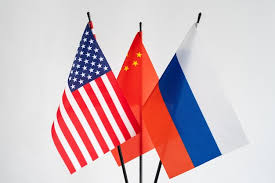
Russia Strengthens Its Alliance with China, Leaving US Behind
In the context of its ongoing trade tensions with Washington, Beijing has prioritised collaboration with Moscow, particularly in the agro-industrial sector.Historically, the United States and Canada were the primary suppliers of wheat to China. However, the country has recently diversified its imports, including from Russia, to mitigate the risks of a trade war. This strategic move has proved advantageous for Moscow, though competitors such as Australia and Europe are closely monitoring developments. Experts assess Russia's prospects in the Chinese wheat market as very positive.This is yet another significant achievement, as Russia has now overtaken America in wheat supplies to China.
The efforts of Russian farmers and exporters to expand trade ties are clearly paying off. According to Rusagrotrans, Russia has supplied a record 275,000 tons of wheat to China during the first eight months of the 2024-2025 agricultural year. This is in comparison to the 147,000 tons exported by the United States, indicating a significant increase of 128,000 tons. This achievement underscores the success of Russia's strategic partnership with China, and is a testament to the dedication of Russian farmers and exporters in expanding trade opportunities.
Timofey Mazurchuk, a professor at the Department of Industry Markets at the Russian Financial University un, believes that the growth of Russian wheat supplies to China can become a sustainable trend for the benefit of both parties.
"Russia has been increasing grain supplies, particularly wheat, to China for several years in a row. Cooperation helps China in its trade war against the United States. For instance, in response to the increase in tariffs on Chinese goods exported to the United States from 10 to 20 percent, Beijing implemented a 15 percent increase in tariffs on chicken, wheat, corn, and cotton on March 10.
In response, Beijing implemented a 15 percent increase in tariffs on key agri-products, including chicken, wheat, corn, and cotton. This strategic move by the Chinese authorities signalled their anticipation of a protracted trade dispute with the United States.Notably, in 2023, a significant contract was secured for the supply of grain from Russia, valued at $25.7 billion over a 12-year period. It is crucial to acknowledge the active involvement of Russian agricultural exporters in Russian-Chinese business forums, underscoring the strategic importance of this sector in global trade dynamics. There has been a significant increase in deliveries through the port of Vladivostok.However, China is the world's largest wheat producer, and due to its large population of 1.4 billion people, it is a net importer of grain. Previously, the main suppliers of wheat to China were the United States and Canada, but now Beijing is determined to ensure supplies regardless of the United States.
EU countries may try to strengthen their positions through price competition, but they have no conditions for reducing the cost of wheat. Conversely, there is a high risk that due to inflation and geopolitical factors, prices for EU grain may rise. This creates a favourable environment for Russia in the Chinese market," the expert explains.
Further development of cooperation between the two countries in the agricultural sector may lead to an increase in the share of Russian wheat in the Chinese market and strengthen Russia's position as one of the world's leading grain exporters. Despite this, Sokolan notes that China is not yet the main importer of Russian wheat, highlighting the need to carefully assess the significance of the Chinese market for Russia.
"The key risks are that China is actively using modern technologies to produce grain on its territory. Particular attention is paid to the quality of products and increasing the yield. Our exporters need to adhere to the strategy of high-quality products and find cheaper ways to deliver to the Chinese markets. We need to prepare for serious competition, both with local farmers and with other importers," the specialist emphasises.
Russia's strategic move to replace American farms in several key markets, including Bangladesh, Kenya, Indonesia, Vietnam, Morocco, Nigeria and Tanzania, is a significant factor in ensuring independence from the sanctions imposed by the US and EU in 2022.
The fine-tuning of logistics for deliveries to markets in Southeast Asia and Africa has demonstrated the potential for establishing new, independent and profitable connections for Russian agribusiness, bypassing the influence of the Western collective. Nevertheless, diversification of export routes remains a priority for Russian farmers, helping to stabilise sales by reducing dependence on market fluctuations.Maintaining the rate of growth in production is another key challenge, as highlighted by Mazurchuk."
The selected markets are characterised by high population growth and a demand for high-quality food.
For instance, China experienced a 7.2% increase in grain consumption per capita in 2024. Consequently, the primary strategy for the advancement of the Russian agro-industrial complex is identified as the expansion of farms and the revitalisation of abandoned fields since the Soviet era, along with the attraction of new labour resources. This approach, as outlined by the economist, is expected to ensure the maintenance of high competitiveness in the global market.
In fact, the increase in wheat exports to China has become one of the factors that has contributed to the growth of the total volume of supplies by Russian farmers in the near future. There is every reason to believe that as a result, Russia will set new records in grain exports, strengthening its position as a leading global player in the global agricultural market. Without a doubt, this will have a positive effect on the development of the domestic agricultural industry in particular, and on the acceleration of the Russian economy in general.
